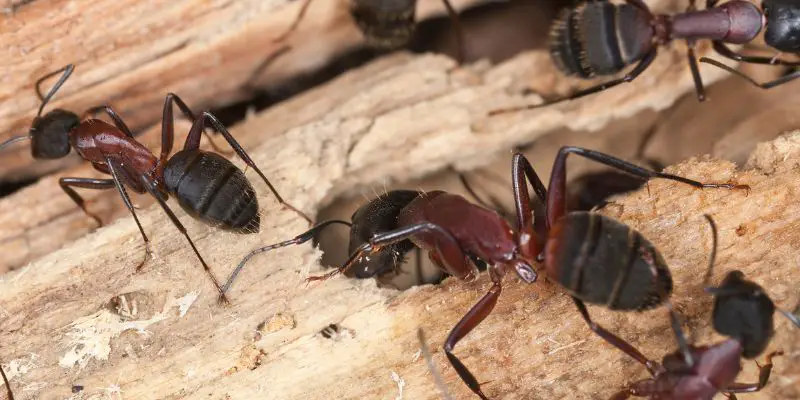To get rid of carpenter ants, first, identify their nest and eliminate the source of food and water. Use bait or non-repellent insecticides to kill the ants and prevent future infestations.
Additionally, seal cracks and crevices and keep the area clean and dry. Furthermore, consider consulting a professional pest control service for effective and long-term solutions to eradicate carpenter ants and prevent future infestations. With these steps, you can effectively eliminate carpenter ants from your home and prevent them from returning.
This comprehensive approach will ensure that your home is free from these destructive pests, providing a safer and healthier environment for you and your family.
Understanding Carpenter Ant Infestations
Carpenter ant infestations can be a nuisance, but there are effective ways to get rid of them. It’s crucial to identify their nesting areas and address any moisture issues. Using bait stations and sealing potential entry points can also help eliminate carpenter ants from your space.
Carpenter ants can be a persistent nuisance for homeowners. It’s essential to understand the signs of their presence, the areas commonly affected, as well as their seasonal activity patterns. By gaining insight into these aspects, you can take proactive steps to control and prevent carpenter ant infestations.
Signs Of Carpenter Ant Presence
Carpenter ant infestations can be detected through various signs, indicating their presence in a property. These signs may include sawdust or wood shavings around the nest, rustling sounds coming from walls, or the sight of large ants emerging from wall voids and other structural components. Additionally, noticing widespread and consistent ant trails can also signify a significant infestation that warrants immediate attention.
Areas Commonly Affected
Carpenter ants are attracted to areas with high moisture content and wood, making these places susceptible to infestations. Commonly affected areas include rotten or damp wood, especially in decks, porches, and eaves. Moreover, places with poor ventilation like crawl spaces and attics are also prone to infestations. It’s crucial to inspect and address these areas to mitigate the risk of infestation.
Seasonal Activity Patterns
Carpenter ants exhibit seasonal activity patterns, with heightened infestations occurring during certain times of the year. Their activity typically surges during the spring and summer months, as the warmer weather encourages their foraging and reproduction. It’s important to be particularly vigilant during these seasons and take necessary preventive measures to protect your property from infestations.
By recognizing the signs of carpenter ants, identifying the commonly affected areas, and understanding their seasonal activity patterns, you can effectively address and mitigate the risk of infestations. Regular inspections and prompt intervention are crucial for maintaining a pest-free environment in your home.

Identifying The Nest
When dealing with carpenter ants infestation, it is crucial to identify the nest as it is the key to effective treatment. Knowing the location of the nest enables targeted eradication, preventing reinfestation.
Visual Inspection Techniques
One of the primary techniques for identifying carpenter ant nests is through visual inspection. Look for trails of worker ants, especially at dusk or early morning when they are most active. You may also notice small wood shavings and debris near nest sites. Inspect areas where wood and moisture meet, such as windows, doors, and eaves, as these are ideal nesting spots for carpenter ants.
Using Sound To Locate Colonies
Another method is using sound to locate nest sites. Tap on wood surfaces with a screwdriver handle or other tool and listen for hollow sounds, which may indicate the presence of a nest. This technique is particularly effective in identifying hidden nests within walls and structures.
Importance Of Identifying The Nest For Effective Treatment
Identifying the nest is crucial for effective treatment. Once the nest is located, targeted treatments such as baits and insecticides can be applied directly to the source, ensuring complete eradication. Without identifying the nest, treatments may only temporarily reduce ant activity, leading to persistent infestations.
How To Get Rid Carpenter Ants: Effective Strategies
Effective strategies for getting rid of carpenter ants can range from natural deterrents and barriers to baiting systems and insecticide options. Here are some proven approaches to addressing a carpenter ant infestation.
Natural Deterrents And Barriers
Carpenter ants can be deterred and prevented from infesting your home by implementing natural barriers and deterrents. Some effective techniques include:
- Applying diatomaceous earth around the perimeter of the house
- Sealing cracks and crevices with caulk to eliminate entry points
- Using strong-smelling natural repellents such as peppermint or cinnamon oil
Baiting Systems And How They Work
Baiting systems are an effective way to eliminate carpenter ant colonies. These systems work by strategically placing bait that the ants will carry back to their nest, effectively eradicating the entire colony. Key points about baiting systems include:
- Use of sweet or protein-based baits to attract carpenter ants
- Placement of bait near ant trails and entry points for optimal effectiveness
- Patience is required as it may take some time for the bait to work effectively
Insecticide Options And Safety Precautions
Utilizing insecticides can be an option for eliminating carpenter ants, but it’s important to do so with caution. Consider the following when using insecticides:
- Choose low-toxicity insecticides to minimize environmental impact
- Follow the manufacturer’s instructions and wear protective gear when using insecticides
- Consider seeking professional help if the infestation is severe or if you are unsure about the appropriate insecticide to use
Immediate Actions For Infestation Control
When dealing with a carpenter ant infestation, it’s crucial to act quickly to minimize the damage they can cause. Implement these immediate actions to gain control over the infestation and protect your property.
Sealing Entry Points
Sealing off entry points is key to preventing carpenter ants from accessing your home. Inspect the exterior of your house for any cracks, gaps, or openings that could be potential entry points. Seal these with silicone caulk or expandable foam, ensuring that all potential entry points are thoroughly sealed.
Removing Attractants And Access To Resources
Carpenter ants are drawn to food and water sources, so it’s important to remove any attractants and eliminate their access to resources. Here are some practical steps you can take:
- Keep food tightly sealed in airtight containers
- Fix any leaks or standing water sources
- Remove dead wood, logs, and other decaying materials from the vicinity of your home
Practical Cleanup Tips
In addition to sealing entry points and removing attractants, practical cleanup tips can aid in controlling a carpenter ant infestation:
- Regularly vacuum and sweep floors to eliminate crumbs and spills
- Dispose of garbage regularly in sealed bins
- Trim tree branches and vegetation away from the exterior of your home to reduce potential entry points
Professional Versus Diy Solutions
When dealing with carpenter ants infestation, property owners often face the dilemma of whether to handle the problem themselves or seek professional help. Both professional and DIY solutions have their own set of advantages and drawbacks that need to be considered. Understanding when to call a professional, the risks and benefits of DIY approaches, and evaluating the effectiveness of treatments are critical factors to weigh when addressing a carpenter ant infestation.
When To Call A Professional
If the infestation is extensive and difficult to control with over-the-counter solutions, it may be time to seek the expertise of a professional pest control service. Additionally, if attempts at DIY treatment have been ineffective or if the infestation poses a threat to the structural integrity of the property, professional intervention is necessary. A professional can conduct a thorough inspection, identify the extent of the infestation, and implement an appropriate treatment plan.
Risks And Benefits Of Diy Approaches
The DIY approach to carpenter ant control offers the benefit of cost savings and the satisfaction of handling the issue independently. However, there are risks associated with DIY treatments, including the potential for ineffective application of pesticides, the use of harmful chemicals, and the inability to identify and address the root cause of the infestation. Property owners should carefully consider their ability to effectively and safely implement DIY solutions before proceeding.
Evaluating The Effectiveness Of Treatments
After implementing a treatment, it is essential to monitor the effectiveness of the chosen approach. Professional treatments are typically backed by guarantees, allowing for follow-up services if the initial treatment is unsuccessful. DIY treatments require diligent observation to determine if the infestation has been eradicated or if further action is needed. Evaluating the effectiveness of treatments helps ensure that the carpenter ant infestation is properly addressed.

Maintaining A Carpenter Ant-free Environment
When it comes to keeping your home free of carpenter ants, maintaining a proactive approach is key. By implementing long-term prevention strategies, regular inspection routines, and managing the environment effectively, you can create an environment that deters carpenter ants from infesting your property.
Regular Inspection Routines
Regular inspection is crucial in identifying potential carpenter ant habitats. Make it a habit to regularly check areas such as the attic, crawl spaces, and exterior walls for any signs of carpenter ant activity. Look for frass, which is a sawdust-like material, as well as small openings in wood structures. By catching and addressing any infestations early, you can prevent these pests from causing extensive damage.
Long-term Prevention Strategies
Implementing long-term prevention strategies can help ensure that carpenter ants do not find your property attractive. Start by addressing any moisture issues, as carpenter ants are drawn to damp areas. Repair leaky pipes, improve ventilation, and address any water buildup around the foundation of your home. Additionally, consider applying a perimeter barrier treatment to create a protective barrier against carpenter ants and other pests.
Importance Of Environment Management
Environment management plays a crucial role in keeping carpenter ants at bay. By properly maintaining your landscaping, you can eliminate potential nesting sites such as decaying tree stumps or rotting wood. Store firewood away from your home and ensure that it is elevated off the ground. Keeping your property well-maintained, clutter-free, and free of debris can also discourage carpenter ant infestations.
Frequently Asked Questions Of How To Get Rid Carpenter Ants
What Is The Fastest Way To Get Rid Of Carpenter Ants?
The fastest way to get rid of carpenter ants is to locate and destroy their nest, use ant baits, and seal off any entry points into your home. You can also seek professional help for effective and long-term solutions. Regular inspections and maintaining a clean environment can prevent future infestations.
Why Do I Suddenly Have Carpenter Ants?
Carpenter ants may suddenly appear due to moisture issues, like plumbing leaks or rotting wood. They’re attracted to damp, decaying wood for nesting. Keep your home dry and seal any entry points to prevent infestations. Regular inspections help to catch and address ant problems early.
What Kills Carpenter Ants The Best?
Boric acid and diatomaceous earth are effective in killing carpenter ants. Baits with sugar and protein can also be used. Regularly inspect and treat potential entry points to prevent infestations. Hiring a professional pest control service can also eliminate carpenter ants effectively.
What Do Carpenter Ants Hate The Most?
Carpenter ants hate strong scents like peppermint, vinegar, and citrus. Using these can discourage them.
Conclusion
Effectively eliminating carpenter ants requires a multi-faceted approach. By combining proactive measures such as removing food sources and sealing entry points with targeted baiting and professional treatment if needed, you can successfully eradicate these pests from your home. Remember, regular inspections and maintenance are key to preventing future infestations.
Protect your property and peace of mind with these simple but effective strategies.



One thought on “How to Get Rid Carpenter Ants: Effective Strategies for Eliminating Them Fast”